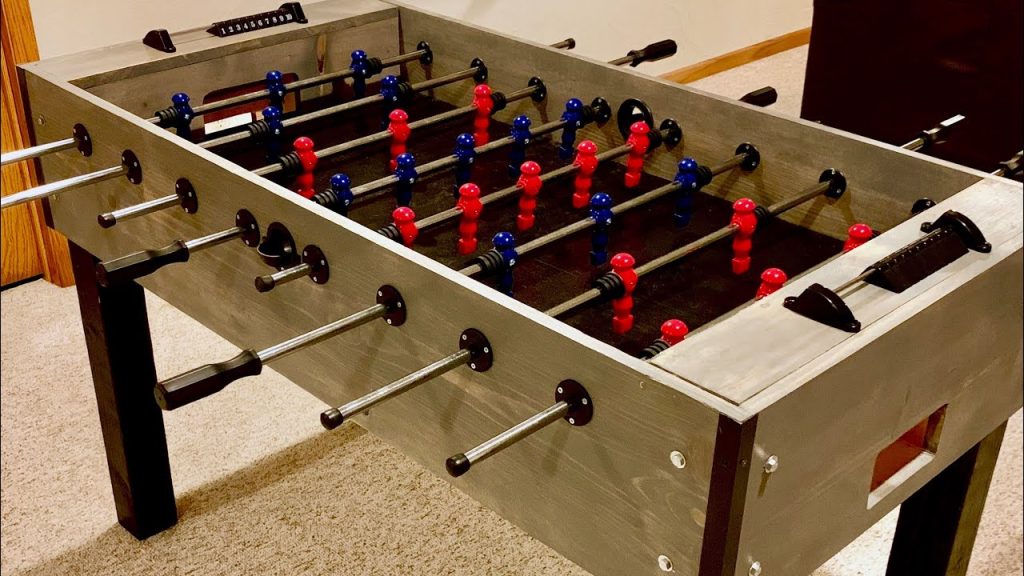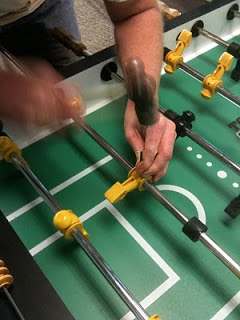Building a foosball table can be a fun and rewarding project. It allows you to customize your own game table.
Do you love foosball? Ever thought about building your own table? This guide will help you create a foosball table at home. You don’t need to be a master carpenter. With some basic tools and materials, you can build a sturdy and enjoyable foosball table.
Whether it’s for family fun or to challenge friends, making your own table adds a personal touch. Plus, it’s a great way to learn new skills and have fun. Ready to get started? Let’s dive in and explore how to build your own foosball table step by step.

Credit: iliketomakestuff.com
Planning And Design
Building a foosball table starts with planning and design. This initial stage ensures your table is functional and aesthetically pleasing. Proper planning leads to a more enjoyable and durable foosball table. Let’s dive into the details of choosing the right dimensions and selecting the design style.
Choosing The Right Dimensions
Choosing the right dimensions is crucial. It affects gameplay and space usage. Here are the standard dimensions for a foosball table:
| Component | Dimensions |
|---|---|
| Table Length | 56 inches |
| Table Width | 30 inches |
| Table Height | 36 inches |
Adjust the dimensions based on your available space. Ensure there’s enough room around the table for movement. This enhances the playing experience.
Selecting The Design Style
Selecting a design style makes your foosball table unique. Consider the following styles:
- Classic Style: Wooden finish, traditional look.
- Modern Style: Sleek, minimalistic design.
- Custom Style: Personalize with colors and logos.
Choose a style that matches your room decor. It should also align with your personal taste.
Use high-quality materials for durability. Wood, metal, and plastic are common choices. Each material has its pros and cons.
Proper planning and design lead to a fun and lasting foosball table. Enjoy the process and the game!
Cutting The Wood
Building a foosball table from scratch is a fun and rewarding project. One important step is cutting the wood. This step requires precision to ensure all parts fit together perfectly. Let’s dive into the details of measuring, marking, and using the right tools.
Measuring And Marking
Begin by measuring each piece of wood carefully. Use a tape measure for accuracy. Make sure to double-check your measurements. Mark the wood where you need to cut. Use a pencil for clear, visible lines. This step is crucial for a perfect fit. Accurate measurements ensure a sturdy and balanced table.
Using The Right Tools
Select the right tools for cutting the wood. A saw is your best friend here. Choose a hand saw or a circular saw. Both are good options for this project. Ensure your saw is sharp. A dull blade makes cutting difficult. Safety is important. Wear safety goggles and gloves. Follow the markings you made earlier. Cut slowly and steadily. This will give you clean, precise cuts. Proper tool use ensures your foosball table parts fit well together.
Assembling The Frame
Assembling the Frame is the first major step in building your foosball table. This step ensures the structure is solid and ready for the next phases. Below, we will guide you through attaching the side panels and securing the base.
Attaching The Side Panels
The side panels form the main structure of your foosball table. Follow these steps:
- Gather your materials: You will need two long side panels and screws.
- Position the panels: Place the panels parallel to each other.
- Attach the panels: Use screws to secure the panels to the corners of the table.
Ensure the panels are aligned properly. This will keep the table stable during play.
Securing The Base
The base supports the entire foosball table. It must be strong and level.
- Prepare the base: Lay out the base board on a flat surface.
- Align with side panels: Place the base within the frame created by the side panels.
- Secure the base: Use screws to attach the base to the side panels.
Check for stability by gently pushing the frame. It should not wobble.
Your frame is now assembled. Ready for the next steps in building your foosball table.
Building The Playing Surface
Creating the perfect playing surface is crucial for any foosball table. The surface needs to be smooth and well-marked. This ensures a fair and enjoyable game. Follow these steps to build a top-notch playing surface.
Creating A Smooth Surface
A smooth surface allows the ball to roll evenly. To achieve this, select a sturdy material like MDF or plywood. Cut it to the dimensions of your foosball table.
- Sand the surface: Use fine-grit sandpaper to smooth out any rough spots.
- Apply a sealant: This helps to protect the surface and keep it smooth.
- Check for smoothness: Run your hand over the surface to ensure it is even.
Once the surface is smooth, you can move on to marking the field lines.
Marking The Field Lines
Field lines help in maintaining the game’s structure. Use a ruler and a pencil to draw the lines.
- Draw the center line: This divides the table into two equal halves.
- Add goal areas: Mark rectangles in front of each goal.
- Draw the penalty areas: These are smaller rectangles inside the goal areas.
After marking the lines, paint over them with a durable paint. This ensures the lines remain visible during intense games.
Here is a sample table for quick reference:
| Field Line | Dimensions |
|---|---|
| Center Line | Width of the table |
| Goal Area | 4 inches by 12 inches |
| Penalty Area | 3 inches by 8 inches |
Now, your playing surface is ready. Enjoy your game!
Installing The Rods And Players
Installing the rods and players on your foosball table is a crucial step. It ensures smooth gameplay and player control. This part of the process involves positioning the rods and attaching the players. Follow these steps to get it right.
Positioning The Rods
Start by identifying the rod positions. Each side of the table has specific slots. These slots are for the defensive, midfield, and offensive rods. Make sure you have the right rod for each position. Defensive rods are shorter. Offensive rods are longer.
Insert the rods through the holes on the side of the table. Ensure each rod matches the layout of a standard foosball table. Double-check the alignment. The rods should move freely. If a rod is tight, reposition it. The rods must glide smoothly for better play.
Attaching The Players
Now, it’s time to attach the players. Each rod has a set number of players. Check the player distribution. Usually, defensive rods have fewer players. Offensive rods have more.
Slide the players onto the rods. Make sure they face the right direction. The players should face the opponent’s goal. Use the screws or clips provided. Secure each player firmly. They should not wobble. Test the rod movement. The players should rotate easily.
Repeat the process for all rods. Ensure every player is correctly positioned. Proper installation enhances your foosball game. Enjoy the smooth and competitive play!
Adding The Finishing Touches
The final steps in building a foosball table involve adding the finishing touches. These steps are essential to ensure your table looks great and performs well. We’ll cover two main areas: installing the goals and painting and decorating your foosball table.
Installing The Goals
Installing the goals is a crucial step for your foosball table. Start by measuring and marking the exact center of each end of the table. This ensures the goals are aligned properly.
Use a drill to make holes for the goal openings. The holes should be wide enough for the ball to pass through easily. Once drilled, attach the goal boxes to the outside of these holes.
Secure the goal boxes with screws to keep them in place. Check that they are level and firmly attached. This will prevent the goals from moving during play.
Here is a simple table to summarize the steps:
| Step | Description |
|---|---|
| 1 | Measure and mark the center of each end. |
| 2 | Drill holes for the goal openings. |
| 3 | Attach goal boxes with screws. |
| 4 | Check that goals are level and secure. |
Painting And Decorating
Painting and decorating your foosball table adds a personal touch. Begin by sanding the table’s surface to ensure the paint adheres well. Use fine-grit sandpaper for a smooth finish.
Apply a primer to the table. This helps the paint stick better and makes the colors pop. Once the primer is dry, choose your paint colors. Use acrylic paint for its durability and bright colors.
You can use stencils for precise designs or freehand for a unique look. After painting, let it dry completely. Apply a clear coat for protection and a glossy finish.
Here is a list of painting and decorating steps:
- Sand the table’s surface.
- Apply a primer.
- Choose and apply paint colors.
- Use stencils or freehand for designs.
- Let the paint dry completely.
- Apply a clear coat.
By following these steps, your foosball table will not only function well but also look amazing. Enjoy your customized, one-of-a-kind foosball table!
Maintenance Tips
Maintaining your foosball table is essential for ensuring longevity and optimal performance. Regular maintenance helps prevent damage and keeps the game enjoyable. Below are some practical maintenance tips to keep your foosball table in top shape.
Regular Cleaning
Regular cleaning is crucial for a smooth and fast game. Use a soft, damp cloth to wipe down the playing surface. Avoid using harsh chemicals.
- Clean the rods with a dry cloth to remove dust and dirt.
- Use a mild cleaner for stubborn spots on the table.
- Clean the ball regularly to keep it free from grime.
Troubleshooting Common Issues
Even with proper care, you might face some common issues. Here are a few tips:
- Sticky Rods: Apply a small amount of lubricant to the rods.
- Wobbly Players: Tighten the screws holding the players in place.
- Uneven Surface: Check and adjust the table legs to ensure a level playing field.
By following these maintenance tips, your foosball table will stay in great condition for years. Enjoy your game!

Credit: www.youtube.com

Credit: www.instructables.com
Frequently Asked Questions
What Materials Are Needed To Build A Foosball Table?
To build a foosball table, you’ll need plywood, screws, rods, foosball men, and handles. Additionally, you’ll require a saw, drill, and measuring tape for accurate assembly.
How Long Does It Take To Build A Foosball Table?
Building a foosball table can take anywhere from a few hours to a weekend. The time depends on your skill level and complexity of the design.
Can Beginners Build A Foosball Table?
Yes, beginners can build a foosball table. It’s important to follow detailed instructions and take your time. Many guides and tutorials are available to help.
What Tools Are Required To Build A Foosball Table?
To build a foosball table, you need a saw, drill, screwdriver, measuring tape, and a wrench. Having clamps and sandpaper can also be helpful.
Conclusion
Building a foosball table can be a rewarding project. You learn new skills and create a fun game for everyone. Follow the steps carefully and take your time. Your efforts will pay off with a table that offers endless entertainment.
Enjoy the process and have fun playing foosball with friends and family. Happy building!


